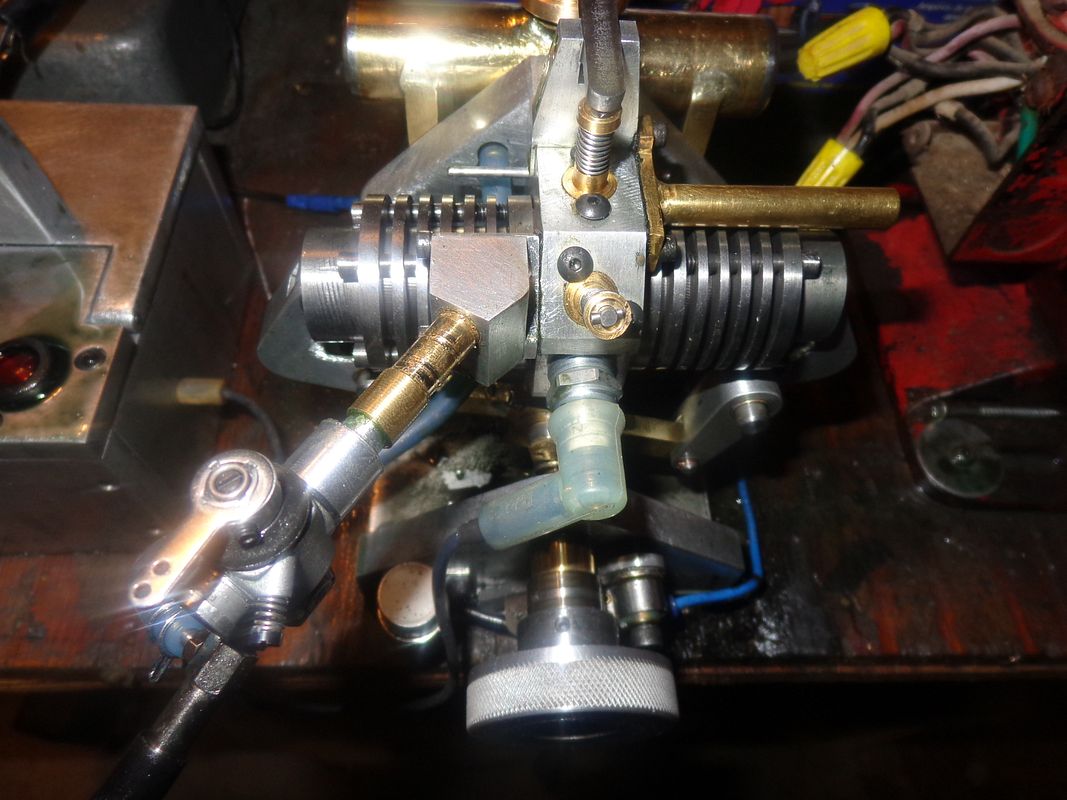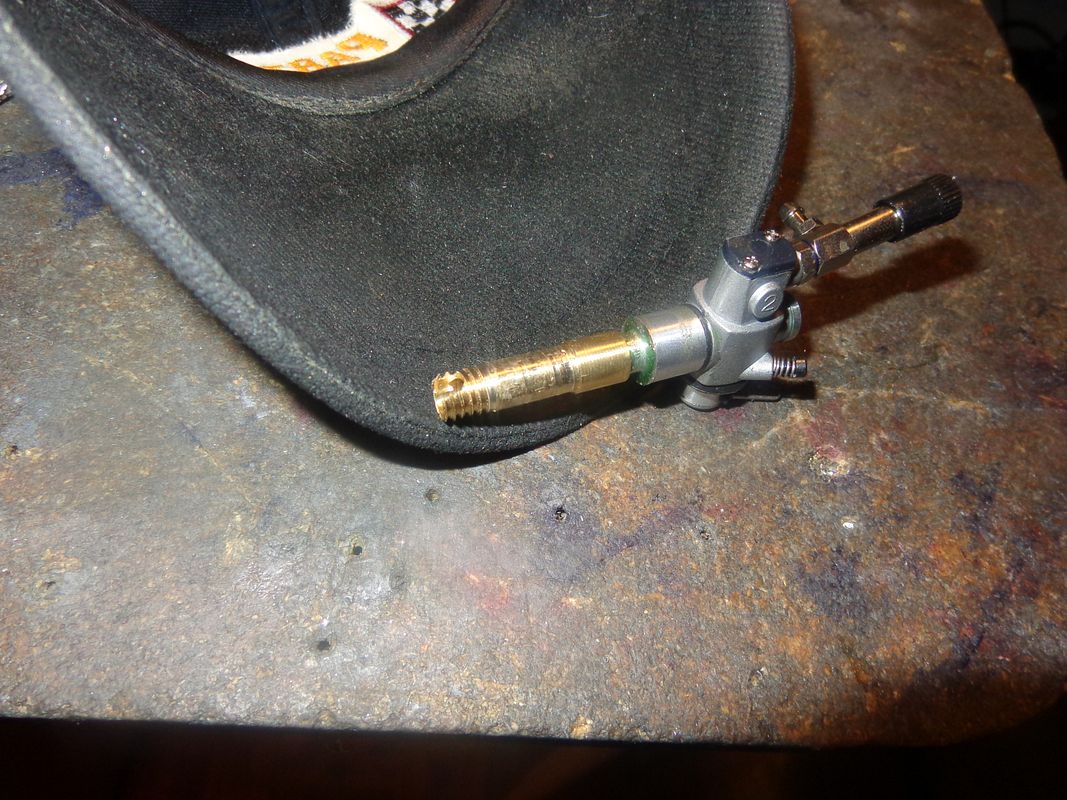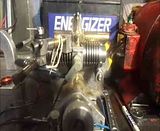Luc--I hold Chuck in very high esteem. We all copy one and other to some extent here, and we all try to be friendly about it. I have posted engine builds that were totally Chucks idea, and tried very hard to explain to people that although I might have posted detail drawings of something, that Chuck Fellows was the originator of the concept. A lot of the time, the person who gets credit for something new is the person who first builds it, runs it successfully and posts a video of it running. There is no room for pettiness nor meanness on this forum.
You are using an out of date browser. It may not display this or other websites correctly.
You should upgrade or use an alternative browser.
You should upgrade or use an alternative browser.
A different opposed piston engine---
- Thread starter Brian Rupnow
- Start date

Help Support Home Model Engine Machinist Forum:
This site may earn a commission from merchant affiliate
links, including eBay, Amazon, and others.
This afternoon I had my first successful long duration run. The engine ran for 3 minutes, and I actually shut it off, it didn't stop on its own. A glass of red wine and an hours nap will do wonders for your thought processes. I went through the engine bit by bit in my head, and I couldn't really fault my design nor build process. It kept coming around to carburation, somehow. I an going to post two pictures---Take a good look at the assembly picture. Note that at the end of that brass tube between the carburetor and the strange shaped inlet manifold, all you see is plain tube--maybe part of one thread. I happen to know that there is almost 3/8 of an inch of thread on the end of that tube. Think about it---the threaded end extends so far into the intake block that there is only very little room for fuel vapour to get past the end of the tube.--so---I would crank the engine until it had drawn enough fuel through the small gap to start the engine. The engine would start, run like gangbusters until it used up the small amount of fuel in the inlet block, then die from fuel starvation. Look at the picture of the carb and inlet tube by itself. I set it up in the mill and milled a 3/16' slot in the underside of the threaded area. Put is back in the engine, and almost immediately had a long duration run.---DOH!!!! The reason I shut the engine off is that the brass tube was beginning to unscrew itself from the intake. Those are not tapered pipe thread, simply 5/16"-18 unc threads. I took it apart, cleaned up both areas with some "hot" paint thinners, added a bit of 638 Loctite and put it back together, and came in the house to post this thread. MAYBE---video tomorrow. MAYBE---I've got another winner after all!!!




Chuck--I'm not sure just where this leaves your carburetor, in all the shuffle. I like it, and I would like to use it, but of course my first priority here is to get a running engine. Once I've got the engine tuned and running satisfactorily with the airplane carb, I may get out my old tried and true test bench, the Webster, and give your carb a whirl on it. The Webster is currently running the same model airplane carb, and it has been a very dependable little engine over the years, so I think it might be a better test bench for your carburetor. The problem with trying it on a new, never before ran engine is that I have too many "unknowns". Once the dust dies down from this opposed piston build, I will definitely fit your carb to the Webster which is more of a "known quantity" and do a thread on how satisfactory it works for me.----Brian
Philjoe5
Well-Known Member
- Joined
- Jul 12, 2007
- Messages
- 1,727
- Reaction score
- 321
Brian,
This opposed engine startup has been a great education for me.
After least weeks problem with my intake valve I decided to slow down and get my engine running with your proven carby. At the moment I have too many unknowns too. If it runs with your carby that will prove the valves and rings are operating properly. Then I can go from there.
Cheers,
Phil
This opposed engine startup has been a great education for me.
The problem with trying it on a new, never before ran engine is that I have too many "unknowns".
After least weeks problem with my intake valve I decided to slow down and get my engine running with your proven carby. At the moment I have too many unknowns too. If it runs with your carby that will prove the valves and rings are operating properly. Then I can go from there.
Cheers,
Phil
Philjoe--Start up are always the most high stress part of an engine build. Especially when the world is watching. I like to post my stuff, warts and all, so that new engine builders can see some of the tricks (and pain) involved. When I first started engine building, that was one of the hurdles that I faced.---Nobody else posted their many attempts and failures. They waited until everything was perfect and then posted and sort of gave the impression--"Heck, this is easy, anybody could do it!!!"---And I would build an engine, and it wouldn't run, and after I had tried all the tricks I knew I simply wouldn't know what to do nor who to ask. It's not that people purposely withheld information. It's just that I didn't know what questions to ask.----I learned back then that the most dangerous and harmful people on any forum are those who, though good intentioned, would suggest things they had heard about somewhere, but never actually done themselves. I try really hard to give advice only on things which I have personally had experience with. It just makes you crazy when an engine won't start, and you don't know why, and there isn't anybody else that knows more than you do that you can go and ask. Been there, done that, and have the tee shirt!!!---Brian
Philjoe5
Well-Known Member
- Joined
- Jul 12, 2007
- Messages
- 1,727
- Reaction score
- 321
Start up are always the most high stress part of an engine build
I agree. Up to that point you may be getting lots of comments about how "good" it looks, but in the end, if it doesn't run, it's not an engine but just a collection of parts.
IC engines bring in so many variables. Valve timing, ignition timing, carburetor design, valve seating and piston ring performance. Did I miss anything? But then when you get a runner, you know you've accomplished something.
It sounds like you're getting close and have done an impressive job of isolating where your problems are.
Cheers,
Phil

$13.99
$24.95
Building an Affordable House: Trade Secrets to High-Value, Low-Cost Construction
Amazon.com

$8.40
$19.95
Building a Shed: Siting and Planning a Shed, Building Shed Foundations, Adding Custom Details (Build Like a Pro Series)
Hafa Adai Books LLC
![DreamPlan Home Design and Landscaping Software Free for Windows [PC Download]](https://m.media-amazon.com/images/I/51kvZH2dVLL._SL500_.jpg)
$0.00
DreamPlan Home Design and Landscaping Software Free for Windows [PC Download]
Amazon.com Services LLC

$89.99
Outdoor Wood Boiler Water Treatment Rust Inhibitor- AmTech 300 & Test Kit
Alternative Heating & Supplies

$99.99
AHS Outdoor Wood Boiler Yearly Maintenance Kit with Water Treatment - ProTech 300 & Test Kit
Alternative Heating & Supplies

$599.00
$699.00
FoxAlien Masuter Pro CNC Router Machine, Upgraded 3-Axis Engraving All-Metal Milling Machine for Wood Acrylic MDF Nylon Carving Cutting
FoxAlien Official

$39.99
$49.99
Sunnytech Low Temperature Stirling Engine Motor Steam Heat Education Model Toy Kit For mechanical skills (LT001)
stirlingtechonline

$33.42
$49.99
Becker CAD 12 3D - professional CAD software for 2D + 3D design and modelling - for 3 PCs - 100% compatible with AutoCAD
momox Shop
barnesrickw
Well-Known Member
- Joined
- Sep 8, 2012
- Messages
- 645
- Reaction score
- 121
The issue with too much compression is usually pre-ignition. Pre-ignition can sometimes cause damage.
Sent from my iPad using Model Engines
Sent from my iPad using Model Engines
Walltoddj
Well-Known Member
- Joined
- Aug 5, 2013
- Messages
- 145
- Reaction score
- 57
Pre-Ignition is usually under load I had no pre-ignition in that engine just no power. You have understand that the engine I ran was on straight methanol with 10 cc of nitro so if I got a pre-ignition my piston was gone in about 2 seconds because did that at one time to much nitro temp gauges go off the wall. Just I found 4 strokes have a hard time starting and running if compression is high.
Todd
Todd
Are you sure you're venting the crankcase? I know your opposed piston design should theoretically have minimum problems with this but if you have high compression and a slight mismatch in sealing or timing between the two sides you may be building up enough crankcase pressure to present the symptoms you're seeing. -Terry
Are you sure you're venting the crankcase? I know your opposed piston design should theoretically have minimum problems with this but if you have high compression and a slight mismatch in sealing or timing between the two sides you may be building up enough crankcase pressure to present the symptoms you're seeing. -Terry
If you take any time at all to read through the thread and look at the pictures, you should realize that the crankcase is completely open to atmosphere.
Alright!!!--This is not what you would call "Ticking over like a Swiss watch", but it is definitely running under its own power. I think this is a "qualifying run". I will keep pecking away until it does just set and "tick over" gracefully but for now I am going to put this up and say "Yes, I have a running engine!!!" Thank you to everybody who followed this long thread, and if any of you out there are considering building it to the plans I posted, all of the drawings are updated and any errors that I found were corrected before I put up the download link.------Brian


Fluffy
Well-Known Member
G'Day Brian,
Very well done.
It's been a great series of posts & I have enjoyed watching your efforts unfolded from start to finish. The plans are in my engines to do file.
Regards,
Don.
Very well done.
It's been a great series of posts & I have enjoyed watching your efforts unfolded from start to finish. The plans are in my engines to do file.
Regards,
Don.
I've sat and watched the video a few times now.---And yes, I must admit, it runs a bit like a threshing machine in heat----However, it does run. That is always the biggest concern.--That they run at all. If they run at all, then you are pretty well 100% sure that thru playing with the timing, and dicking about with the carburetor needle valve and one or two other minor adjustments, that it can be made to run smoothly and slowly. Running at all is one Heck of a milestone. If you can't get them to run at all, then you most definitely can not tune them to be smooth and graceful. When you build to somebody else's design, you generally have the certainty that as long as you follow the blueprints, you will end up with a runner. A bit of Youtube searching will turn up half a dozen engines built to the same set of plans, all setting there ticking over nicely. When you design from scratch, there is always that bit of uncertainty in your mind--"Gee--What if I overlooked some major feature that will prevent it from running at all." The feeling I get when I design from scratch and see it draw its first breath and run on its own is the same feeling I got when I built my very first wobbler (oscillating air engine) and seen it take off and spin on its own. YAHOOOOOOOOO!!!
- Joined
- May 27, 2010
- Messages
- 2,999
- Reaction score
- 1,171
Hi Brian,
Great engine.
Just got back from not too cold Tokyo,Japan and about to plunge into finishing up the H&M.Did suffer a bit of burnt-out after building two engines last year. I am OK now.
Later in the year will take good hard look at building your new engine.
Great engine.
Just got back from not too cold Tokyo,Japan and about to plunge into finishing up the H&M.Did suffer a bit of burnt-out after building two engines last year. I am OK now.
Later in the year will take good hard look at building your new engine.
Gus--Nice to hear from you. Burn out---Yes, I can understand that!!!
Swifty
Well-Known Member
Great engine Brian, the work that you put in to drawings and building is to be commended.
Paul.
Paul.
BaronJ
Grumpy Old Git.
Hi Brian,
Yeah its alive... Good one, nice to see it that runs.
Yeah its alive... Good one, nice to see it that runs.
Similar threads
- Replies
- 95
- Views
- 12K
- Replies
- 510
- Views
- 71K
- Replies
- 22
- Views
- 2K

















































